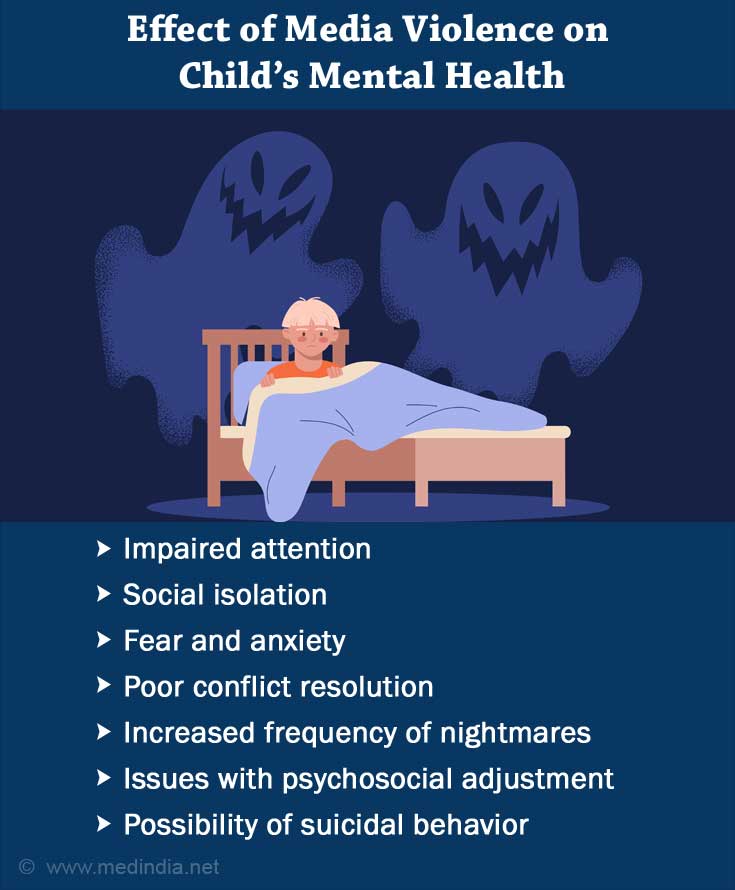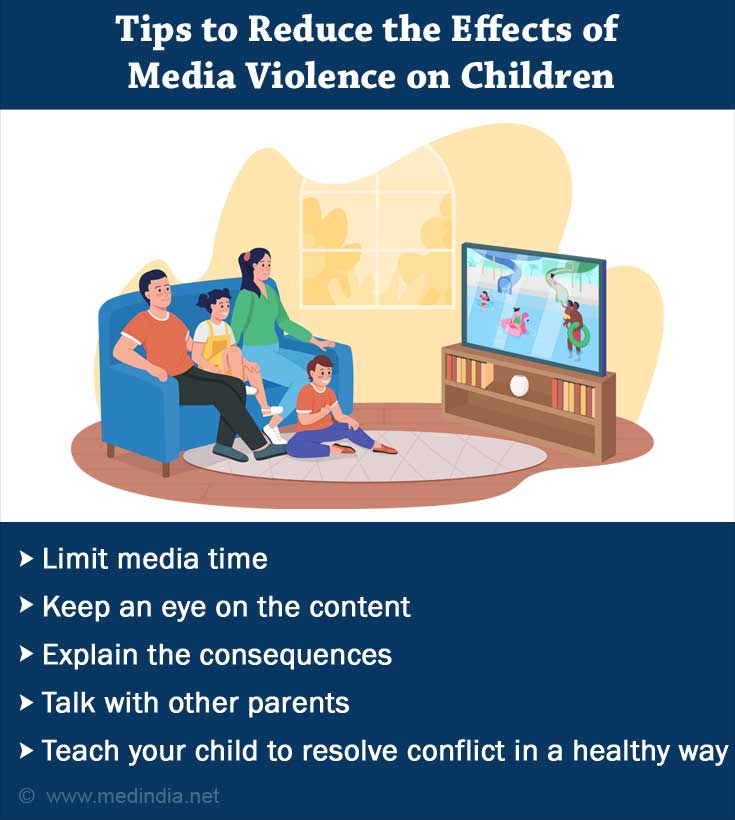- Media Violence Effects on Children, Adolescents and Young Adults - (https://www.chausa.org/publications/health-progress/article/july-august-2016/media-violence-effects-on-children-adolescents-and-young-adults)
- Six Kinds of Screen Violence - And How Children Respond - (https://www.medialit.org/reading-room/six-kinds-screen-violence-and-how-children-respond)
- The Impact of Electronic Media Violence: Scientific Theory and Research - (https://www.ncbi.nlm.nih.gov/pmc/articles/PMC2704015/#:~:text=Most%20researchers%20define%20media%20violence,human%2Dlike%20character%20against%20another.)
- The Relationship Between Media Violence and Aggressive Thoughts - (https://sites.psu.edu/aspsy/2018/03/18/the-relationship-between-media-violence-and-aggressive-thoughts/)
- Media and mental health - (https://www.ncbi.nlm.nih.gov/pmc/articles/PMC6198586/)
- Media Violence - (https://publications.aap.org/pediatrics/article/124/5/1495/72111/Media-Violence)
- The Media Literacy of Children and Young People - (https://www.researchgate.net/publication/253736824_The_Media_Literacy_of_Children_and_Young_People)
- How To Teach Kids Media Literacy - (https://www.huffpost.com/entry/parents-teach-kids-media-literacy_l_5fab43e3c5b6ed84597c3fc4#:~:text=Media%20literacy%20develops%20the%20ability,streaming%20service%20Pinna%2C%20told%20HuffPost.)
What is Media Violence?
Violence, as defined by WHO, is “the intentional use of physical force or power, threatened or actual, against oneself, another person, or against a group or community, that either results in or has a high likelihood of resulting in injury, death, psychological harm, maldevelopment or deprivation.”
Media violence can be defined as aggression displayed on-screen towards character/s, which has the potential to cause harm in some form. This could be either physical aggression that is commonly portrayed or relational aggression that involves harsh communication between characters(1✔ ✔Trusted Source
Media Violence Effects on Children, Adolescents and Young Adults
Go to source). Movies and soap operas often portray violence to the extent that it has become anticipated(2✔ ✔Trusted Source
The Impact of Electronic Media Violence: Scientific Theory and Research
Go to source).
Without our knowledge, everyday, we are bombarded with various aggression through media. When media has a significant influence on adults, it is obvious that children, who are at an impressionable age, are also susceptible to being influenced by such content.
Although 60% of television shows watched by children contain violence, 40% of it had high levels of violence. The child being an active participant in the video games, and the violence accounting for 94%in it, could have more impact on their behavior(3✔ ✔Trusted Source
The Relationship Between Media Violence and Aggressive Thoughts
Go to source).
What is the Relationship Between Media and Violence?
Media has the potential to influence masses. When contents, such as body shaming, glorification of fair skin, hype related to sexual acts and stalking, are not portrayed in a responsible manner, it can lead to hazardous implications among public. Moreover, violence in the media is an area that needs a lot of attention.
Watching aggression on screen can increase the chances of aggression in real life. We may not always be aware of how this process occurs. This is due to priming, a subconscious tendency to be affected by stimuli that was watched previously. Children and adults who watch violence in media are likely to experience more aggressive thoughts and engage in more violent behavior(4✔ ✔Trusted Source
Six Kinds of Screen Violence - And How Children Respond
Go to source).
An individual who has continuous exposure to violent content is likely to be more aroused and respond more aggressively, if provoked right after. This could be due to reduced inhibitions or increased arousal. As a result, the long-term effects of exposure to aggression are observational learning or mimicry(4✔ ✔Trusted Source
Six Kinds of Screen Violence - And How Children Respond
Go to source). Observation of a particular behavioral pattern increases the likelihood of engaging in the same pattern due to the presence of mirror neurons.
Multiple studies show the tendency to be aggressive immediately after consuming a form of media with aggression(2✔ ✔Trusted Source
The Impact of Electronic Media Violence: Scientific Theory and Research
Go to source). This could be while playing a sport, watching the aggressive content, or in experiments in the form of administering more severe punishments. The negative effects of media violence also include hostile attribution bias or a tendency to look at vague and ambiguous situations as hostile in nature. This can fuel unnecessary aggression.
What are the Types of Media Violence?
Media violence has been classified based on their nature as(5✔ ✔Trusted Source
Media and mental health
Go to source):
- Reality or believability of violence – When the fights portrayed are realistic, the chances for imitation increases.
- Rewarding violence – When the protagonist or antagonist goes unpunished for engaging in aggression, it is a kind of reinforcement for such acts.
- Aggressive role models – An actor being the role model engages in aggression, it can lead to an increased chance of mimicry.
- Extent of violence – High exposure to violence can lead to emotional numbing and desensitization.
- Violent connection to character – When a child, especially, connects to the violent thoughts or behavior of a character, this increases the chances of the child emulating their behavior.
- Justification for violence – Justified violence is likely to encourage aggressive tendencies.
What is the Effect of Media Violence on Child’s Mental Health?
The influence of violent content has been studied widely for implications on the mental health of a child. The effects of aggressive and violent behavior shown on media include(3✔ ✔Trusted Source
The Relationship Between Media Violence and Aggressive Thoughts
Go to source):

- Impaired attention that leads to ADHD that is also linked to impulsive aggression(1✔ ✔Trusted Source
Media Violence Effects on Children, Adolescents and Young Adults
Go to source). Internet or gaming disorder is also a possibility where involvement in gaming leads to significant impairment.- Desensitization to media violence and aggression can spill into real life, where a child is not as bothered when they watch aggression.
- Social isolation and the tendency to engage in antisocial acts or delinquency.
- Perception of the world as more dangerous, than it really is, can lead to fear and anxiety.
- Increased frequency of nightmares.
- Issues with psychosocial adjustment and performance in school
- Possibility of suicidal behavior as the negative effects of media violence is very concerning.
- Poor conflict resolution and interpersonal skills are likely to be developed.
How Can We Reduce the Effects of Media Violence on Children?
Media has become an integral part of modern life for every individual. Media violence greatly affects the behavior of the child even after a long time of watching it. The process of teaching children about media must start early as media consumption starts early. So, here are some tips for all parents:

- Limit media time: The effect of media violence on children can be reduced by limiting time spent watching movies and television shows, and playing video games.
- Keep an eye on the content: Adult supervision and input before or during screen time can help children to have a more balanced perspective instead of negative attitudes and behaviors(6✔ ✔Trusted Source
Media Violence
Go to source). Prosocial media consumption can reduce the effects of violence and aggression shown on screen. - Teach to be a critical consumer: Media literacy is a crucial way to reduce the effect of media violence. This involves understanding and analyzing media with the use of critical thinking skills to form informed opinions and take appropriate action. Helping children understand the validity and credibility of information and differentiate fact and fiction, forms the crux of this. Explaining kids that advertisements are acted out and there are more perspectives than what is shown on screen can benefit children. Also, explaining which sources of media to trust can make them a efficient media consumers(7✔ ✔Trusted Source
The Media Literacy of Children and Young People
Go to source). - Explain the consequences:Teach your child the pros and cons of media violence and the consequences of watching in the long run.
- Teach how to resolve conflict in a healthy way.
- Discuss with other parents and find their TV or media management.
- Finally, asking questions, encouraging discussion, modeling media literacy skills as parents, and employing relevant resources can greatly enhance the process(8✔ ✔Trusted Source
How To Teach Kids Media Literacy
Go to source).






